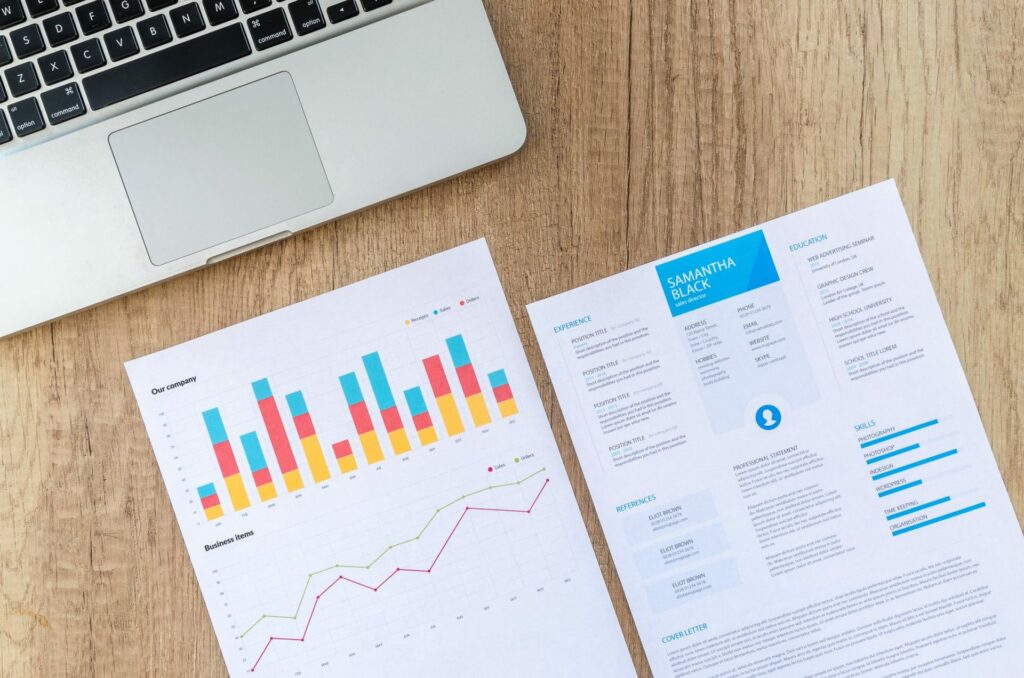
My sister can’t resist a bargain. She’ll go into town to buy a new pair of shoes… And return with three shopping bags filled with makeup and a new jumper, sweets and who knows what other unintended purchases. She then loves telling me all about the great deals she got. But the truth is, most people are guilty of an impulse buy here and there.
Around 84-86% of Americans admit to making impulse purchases in-store and online. Whether they’re consumers who make a spontaneous purchase here and there or they’re regular impulse buyers, this is clearly an important segment you can target to increase sales. Now the only question is, how can you draw out this type of customer’s natural impulses?
Well, it all starts with establishing the personality traits of the impulse buyer.
Take a look:
What Is the Impulse Buyer’s Persona?
If you want to segment and target customers effectively, you need to establish customer personas. They provide a deep understanding of the behaviour and desires of different segments of your audience. Which you can use to provide a better overall customer experience. In fact, using marketing personas makes websites 2-5 times more effective and easier to use for targeted users.

When it comes to impulse buyers, you no doubt want answers to the following questions:
- What drives them?
- And which psychological tactics can you use to improve the way you market to them?
According to analysis from Crazy Egg, this is the first key attribute you need to recognise:
“Spontaneous buyers delight in quick purchases with perceived emotional benefits rather than following logic.”
They also claim that impulse buyers…
- Are prone to distraction
- Get impatient during purchase decisions
- Don’t like traditional processes
- Make decisions subjectively
Another discussion of the motivations behind impulse buying comes from Ian Zimmerman at Psychology Today.
Zimmerman believes that impulse buyers…
- Find it difficult to control their emotions
- Use shopping as a means to improve their mood
- Are social and make purchases to boost their image
- Are less likely to think about the consequences of buying
So, impulse buyers have distinct characteristics that drive their buying behaviours. This is powerful information that you can use to your advantage.
But how do these common personality traits and behaviours translate into marketing strategies?
Create an Emotional Response
All customers are driven by emotions when they make a purchase. Even the dude from American Psycho loved his material items out of a sense of vanity. But the particular emotion we must look at for impulse buyers is their fear of missing out (FOMO). You can heighten the emotional response by creating a sense of urgency surrounding a purchase.
Impulse buyers want to snatch up a deal before it’s gone. This is a strategy that has proven to be successful for many e-commerce brands. In one case study, an entrepreneur made a limited number of Groupon package deals available for just 100 hours.
He emphasized the sense of urgency by adding a countdown timer to his landing page:

This evoked a big old FOMO response in buyers that helped him increase sales by 332%.
Here are a couple of other ways you can create a sense of urgency that forces impulse buyers to take action:
1. Offer Free Shipping for a Limited Time
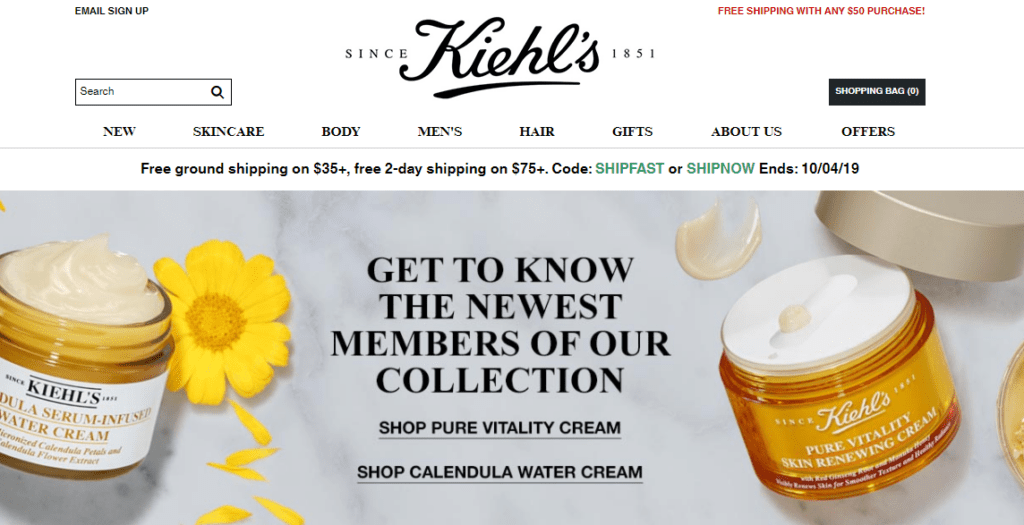
Shipping costs can be a deal-breaker for potential customers. In the above example, Kiehl’s displays their limited time offer of free shipping prominently on their homepage. So, there are no shipping costs to hold an impulse buyer back but only if they act now.
2. Offer Limited Time Deals

Many e-commerce stores offer “Today Only” deals. Here, Target cleverly creates a two-week event out of their daily deals. It’s likely to spark curiosity and encourage visitors to make purchases that they might not usually. They also rally excitement by giving customers the option to preview upcoming daily deals. By creating a sense of urgency you can evoke a range of emotions in impulse buyers.
3. Cross-Sell and Upsell Products
Impulse buyers are the perfect customers to upsell or cross-sell. As we know, they’re spontaneous and unlikely to think about the consequences of putting that extra complimentary item in their cart. They simply want a good deal. And the bottom line is, cross-selling and upselling is excellent for business.
Dan Magill at WooCommerce says;
“Consistently upselling and cross-selling to new and existing customers can increase revenue double digits, depending on your business. Not using this time-tested marketing strategy means you’re leaving money on the table.”
Upselling means increasing a customer’s average order value by offering a premium version of the product or a better deal on multiple items.
For example, you might give the customer a discount if they buy several of your products at once (a multipack):

Cross-selling is slightly different as it means offering products that compliment the item the customer is interested in.
For example, clothing stores often recommend complementary garments and accessories:
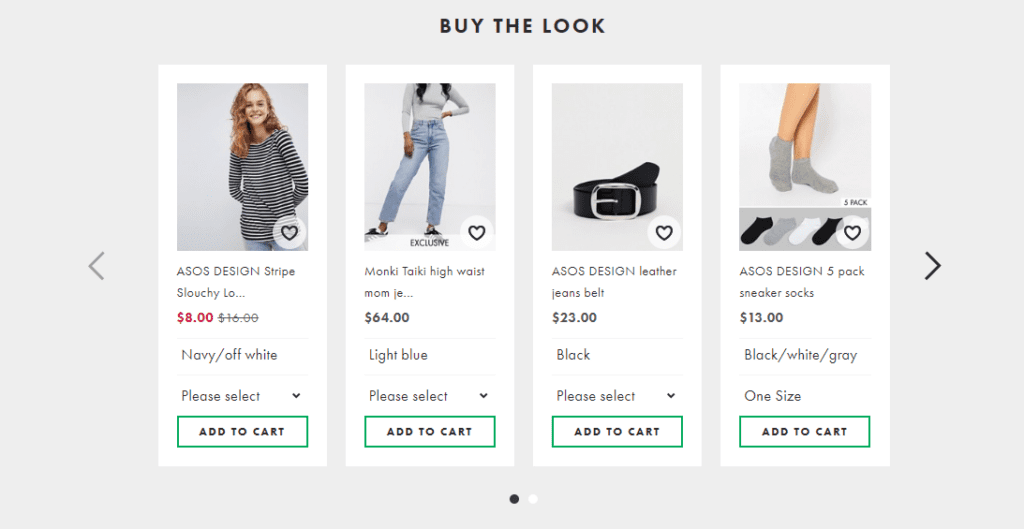
Here are some tips on how to cross-sell and upsell effectively:
1. Placement is Everything
You have a bunch of opportunities to make your move:
- The checkout page
- Product pages
- In a post-purchase email
- Via a popup message
Test out these different options and monitor your sales to discover which works best for your store.
2. Make a Reasonable and Relevant Offer
Your upsell or cross-sell must be relevant to the product in question. As opposed to just a random product recommendation. Furthermore, you should minimize the difference in price so the offer seems reasonable.
For instance, when you buy a growler bag from Brothers Leather Supply, they give you the chance to get a growler for $10:
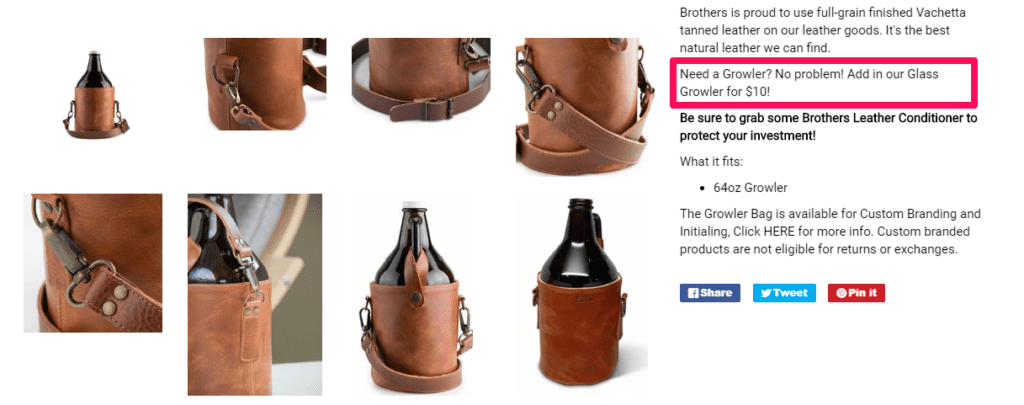
The offer makes complete sense and the low price doesn’t seem like such a stretch. Make a good offer at the right time and impulse buyers won’t be able to resist.
3. Run a Flash Sale
Impulse buyers are drawn to sales. A flash sale is a particularly good idea because it incorporates a sense of urgency. Many flash sales last no more than 24 hours, some last only a couple of hours. This triggers an impulsive reaction as customers know that items will be more expensive in a very short space of time. Therefore, flash sales can achieve monumental results.
When Cardi B collaborated with Fashion Nova on a pre-Black Friday flash sale, her clothing line sold out in just three hours and made nearly $11 million.

No doubt customers rushed to the online store for fear of missing out on Cardi’s new line.
Here’s how to run your own flash sale:
1. Pick the Right Products
It might be difficult to ascertain which products to include in your flash sale if you have a large catalogue. But you do have a few options in this case. Discover which product keywords your target customers are searching for.
Or simply choose popular products or seasonal items:
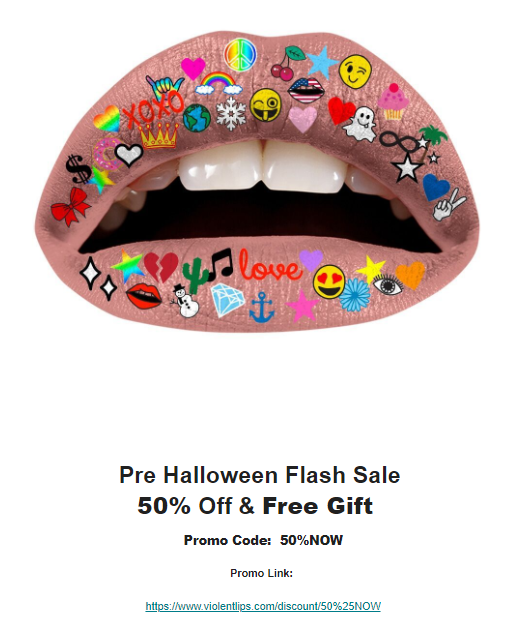
2. Promote Shortly Before the Sale
Impulse buyers are enticed by a quick, non-traditional buying process. If you market your flash sale weeks in advance you lessen the sense of urgency. Therefore, you should promote your flash sale via email, social and Google Ads a couple of days or even just hours before it commences. When done correctly, flash sales feed the desires of impulse buyers.
4. Make Buying Easy
Impulse buyers are impatient. So, your job is to make the customer journey as quick and easy as possible. The best way to do this is by creating a positive user experience. Which will be hugely beneficial for your business, too…
Sites designed with the user in mind can see an increase in conversions of up to 200%. The point is, you need to help impulse buyers come to a quick, simple decision. For instance, provide only one cross-sell so impulse buyers aren’t bogged down with too many choices. And make sure your site is not only easy to use but works exceptionally hard for them.
Next does this by placing popular subcategories at the top of their category pages:

Here are a couple of ways to boost user experience:
1. Check for Usability Problems
Customers don’t notice if your site is working perfectly… They just expect it. Thus, it’s better to monitor for any usability issues.
Does your site load quickly? Has all of the information that a customer would need being displayed clearly? Can they search for and find products easily? Etc.
If usability is good, it takes minimal effort for impulse buyers to make a purchase.
2. Optimize for Mobile
It’s predicted that by 2021, over half of the e-commerce sales in the US will be made on mobile. So, you need to make sure users have an optimal experience on mobile as well as desktop. Plus, mobile is the perfect place to encourage impulse buyers. They can make purchases from anywhere at any time. Essentially, the easier the journey is, the greater the likelihood of an impulse buy.
5. Use Social Proof
Impulse buyers are social and image-conscious. Therefore, if you market a product as a hot item, they’ll just have to have it. You can do this easily by providing social proof, of which there are several forms… Positive customer testimonials, for example, prove that an item is popular among buyers. Plus, when a customer interacts with a review they are 58% more likely to convert.
Social proof not only shows that unbiased parties have used and benefited from your products… But also encourages the impulse buyer’s desire to conform and buy the product for themselves, too.
Here are some examples you can emulate:
1. Ratings and Reviews

Star ratings are customary these days. Here, the rating gives customers an extra push on the product page. In other words, they don’t have to seek out reviews or ratings elsewhere. Which is also good for impulse buyers as they’re looking for a simple, easy process.
2. User-Generated Content

Most online stores source user-generated content from social media e.g. Instagram.
Which works well. Moleskine has gone even further by creating a community where customers can upload the artwork they’ve created in their notebooks. They encourage potential buyers to act as using this product is the only way to be a part of the community. Which is a great example of how through social proof you fulfil the impulse buyer’s need to be social and boost their image.
6. Target Them Where They Hang Out
When you know where your audience hangs out, it makes life a whole lot easier. You can determine which marketing channels are best for targeting impulse buyers. And gain further insights e.g. what kind of content they engage with, their likes and dislikes and so on. You learn how to speak their language. Plus, what it takes to entice them to your e-commerce store. Social media is a good place to start.
The reason being, most impulse buyers fall into the 18-24 category. In other words, Gen Z and young millennials, and you know they love social media more than they love their own families. But how do you work out exactly where they hang out?
1. Use Your Keywords
Search relevant terms related to your products on social media and forums. Let’s say you sell furniture, you might search for terms such as “interior design” or “home decor”. This will help you find Facebook groups, Pinterest group boards, subreddits and the like where you can market your brand or products.

2. Delve Deeper
Once you know where your audience hangs out online you’ll want to do some further research. What kind of content do they share and from which sites? Not only will this help inform your content and social media marketing strategies… But you also get an idea of sites and blogs you can use for guest posting or display ads.
As you can see, it’s beyond useful to know where your ideal customers hang out and what they do there.
Final Word
To create an effective marketing strategy for impulse buyers, you must first look at their key characteristics. This will help you come up with tactics to tempt them. Impulse buyers make purchases based on their emotions so you need to appeal to their fear of missing out. Also, they can’t resist a good deal which makes strategies such as upselling and flash sales particularly effective. They want to be able to make quick purchases with minimal effort, so make the process easy for them.
And they’re social characters so they respond to social proof and spend their time on social media which is the perfect place to reach them with your marketing strategies.
Now it’s up to you to implement these strategies.
To begin with, try making a list of traits you associate with impulse buyers.
About the Author
Emil Kristensen is the CMO and co-founder of Sleeknote: a company that helps e-commerce brands turn their website browsers into buyers—without hurting the user experience.
If you’re looking for a woocommerce developer in the UK, we’ll be happy to help, call us on 0115 971 8908.

